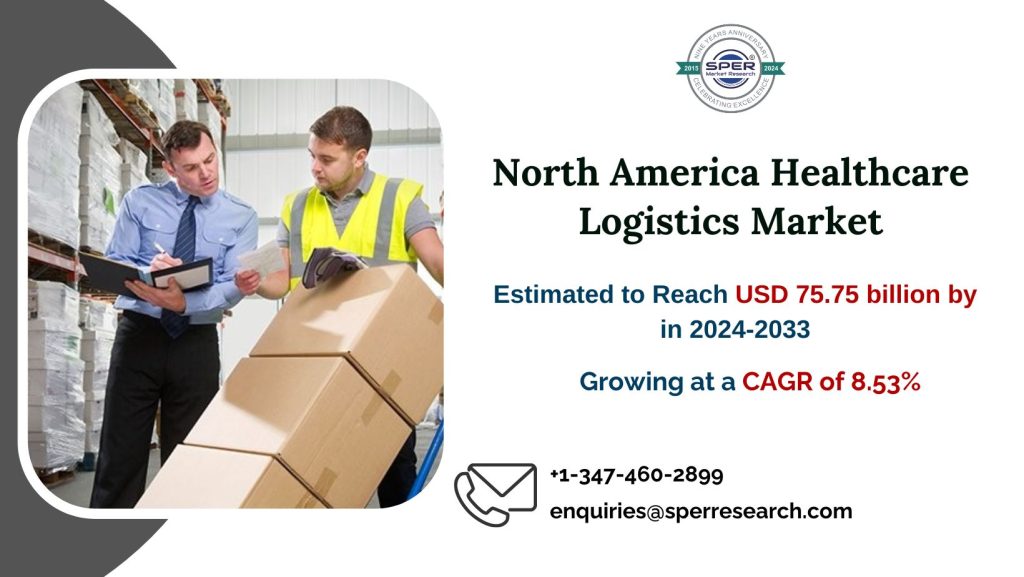North America Pharmaceutical Logistics Market Forecast to Reach USD 75.75 Billion by 2033 with a CAGR of 8.53%: SPER Market Research

Managing and distributing prescription drugs, medical equipment, and other healthcare-related goods along the supply chain is known as healthcare logistics. To guarantee the prompt and effective delivery of healthcare supplies to patients, healthcare facilities, and clinicians, it includes procedures including inventory management, transportation, warehousing, and regulatory compliance. The intricate supply chain of healthcare products must be managed with operational efficiency. An efficient movement of medical supplies from producers to end users, such as hospitals and patients, is ensured by health logistics, which is the methodical planning, carrying out, and monitoring of procedures. In order to maximize efficiency and address obstacles, effective health logistics not only includes the actual transportation of goods but also integrates data management and technology.
According to SPER Market Research, ‘North America Healthcare Logistics Market Size- – By Type, By Components, By Temperature Type, By Logistics, By Logistics Type, By Application, By End-User – Regional Outlook, Competitive Strategies and Segment Forecast to 2033’ states that the North America Healthcare Logistics Market is estimated to reach USD 75.75 billion by 2033 with a CAGR of 8.53%.
Drivers: Notably propelling the market growth are legislative and regulatory changes that favor the expansion of the pharmaceutical business. Medical and pharmaceutical sectors’ strict laws have a direct effect on the number of people who choose to receive medical care, and they also stimulate the expansion of the pharmaceutical sector. In order to lower the cost of prescription medications, the Canadian government has implemented rules. The country’s Patented Medicines Regulations are expected to undergo final revisions as a result of this law. Drug sales are boosted by these restrictions because they cut the cost of pharmaceuticals and increase public accessibility to them.
Restraints: It is very important to manage product expiration dates, especially for medications and perishable goods with short shelf life. weighing the danger of overstocking and related expenses against the necessity of storing essential supplies in reserve. Transportation, warehousing, and specialist handling are just a few of the expenses connected with healthcare logistics. Due to their typically limited resources, healthcare organizations and providers may not be able to spend as much in technology and improved logistics. Cost-cutting measures that preserve high standards of service and compliance are under constant strain. Inefficient technology that may not work well with contemporary systems is used in many healthcare logistics operations, which can result in data silos and inefficiencies.
Request For Free Sample Report @ https://www.sperresearch.com/report-store/north-america-healthcare-logistics-market.aspx?sample=1
Covid-19 Impact: The healthcare and logistics markets were heavily influenced by COVID-19. New rules and regulations were brought about by the pandemic for the storage, distribution, and management of medical supplies, particularly those connected to COVID-19. Businesses had to deal with changing legislation and make sure that higher safety and quality standards were being met. The need for effective logistics solutions suited to these models grew with the emergence of e-pharmacy services and direct-to-consumer healthcare delivery choices. In order to manage prescription drugs and health items effectively, delivery networks had to be created and improved. In order to improve resilience and capacity, the pandemic led to a rise in investment in logistical infrastructure, including distribution centers and technological systems.
Due to the extensive use of e-commerce, North America is anticipated to lead the industry.
Major players in the market are FedEx Corp, Hellmann Worldwide Logistics SE and Co KG, Lineage Logistics Holdings LLC, Noatum Holdings SLU, and United Parcel Service Inc, and Others.
North America Healthcare Logistics Market Segmentation:
By Type: Based on the Type, North America Healthcare Logistics Market is segmented as; Non-Cold Chain, Cold Chain.
By Components: Based on the Components, North America Healthcare Logistics Market is segmented as; Hardware, Services, Software.
By Temperature Type: Based on the Temperature Type, North America Healthcare Logistics Market is segmented as Ambient, Chilled/Refrigerated, Frozen, Cryogenic.
By Logistics: Based on the Logistics, North America Healthcare Logistics Market is segmented as Transportation, Packaging, Storage, Others.
By Logistics Type: Based on the Logistics Type North America Healthcare Logistics Market is segmented as Overland Logistics, Sea Freight Logistics, Air Freight Logistics, Contract Logistics.
By Application: Based on the Application, North America Healthcare Logistics Market is segmented as Medicine, Bulk Drug Handlers, Vaccine, Chemical and Other Raw Material, Biological, Material and Organs, Hazardous Cargo, Others.
By End-user: Based on the End-user, North America Healthcare Logistics Market is segmented as Biopharmaceutical Companies, Hospital and Clinics, Research Institutes, Others.
By Region: This research also includes data for Canada, Mexico and United States.
This study also encompasses various drivers and restraining factors of this market for the forecast period. Various growth opportunities are also discussed in the report.
For More Information, refer to below link –
North America Healthcare Logistics Market Size
Related Report –
Follow Us –
LinkedIn | Instagram | Facebook | Twitter
Contact Us:
Sara Lopes, Business Consultant – U.S.A.
SPER Market Research
+1-347-460-2899





